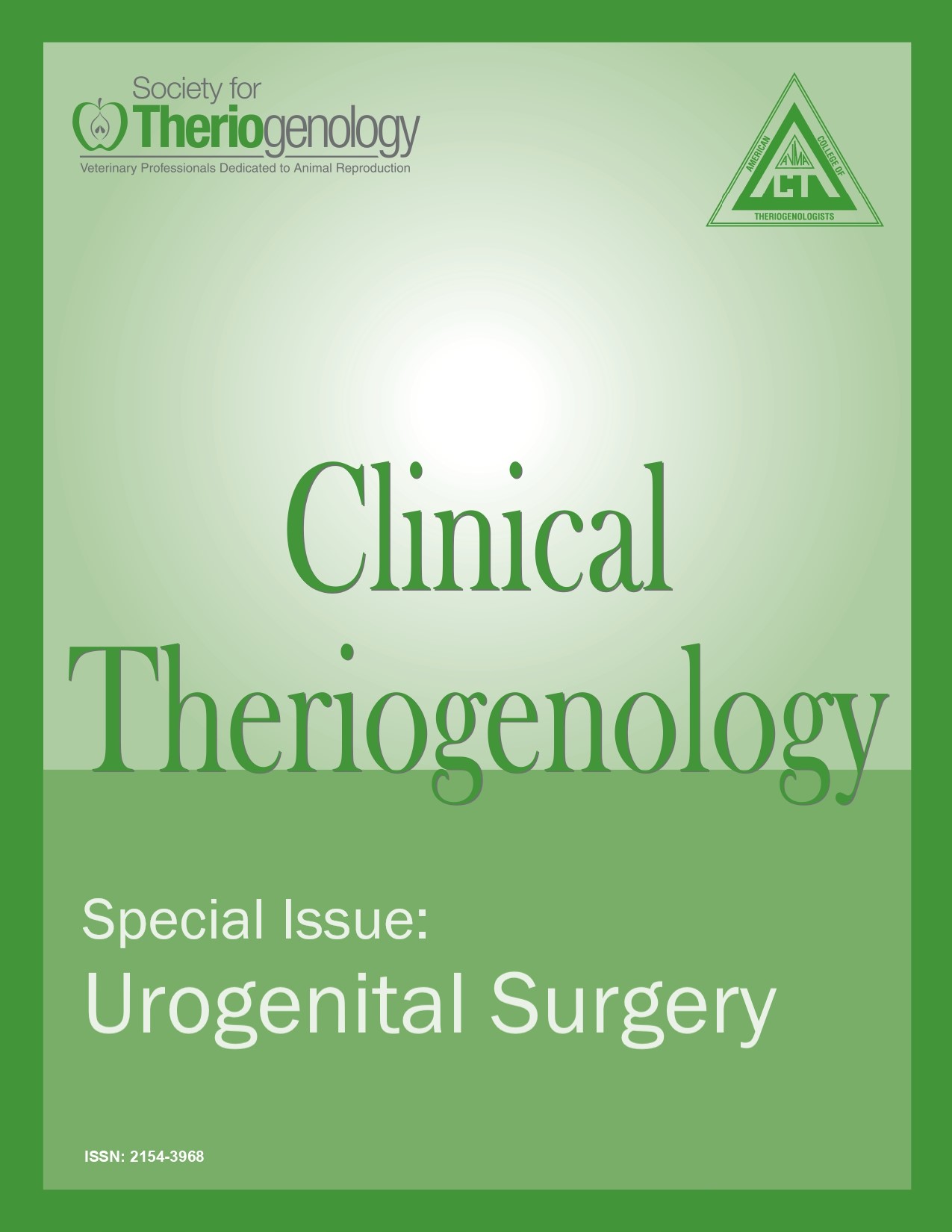Cesarean section in camelids: indications, technique, survival, and postoperative fertility
Abstract
Cesarean section is the most common surgery of the reproductive tract in camelids. However, limited information is available on indication, surgical approach, dam survival, postpartum complications, and neonatal survival following cesarean section in camelids. The objective of this study was to retrospectively evaluate medical records on 84 camels, 29 alpacas, and 3 llamas to evaluate the above factors. Incomplete cervical dilatation (56%; n = 65/84) and uterine torsion (59.4%, n = 19/32) were the most common indications for cesarean section in camels and South American camelids (SACs), respectively. The neonatal survival (SAC: 46.9%, n = 15/32; camels: 76.2%, n = 64/84) was acceptable, and postoperative fertility was excellent (SACs = 75.86%, camels = 72.6%).
Downloads
References
2. Tibary A, Rodriguez J, Sandoval S: Reproductive emergencies in camelids. Theriogenology 2008;70:515–534. doi: 10.1016/j.theriogenology.2008.04.024
3. Tibary A, Rodriguez JS, Anouassi A, et al: Management of dystocia in camelids. American Association of Bovine Practitioners Conference Proceedings; 2008 September 25–27; Charlotte, North Carolina; 2008. p. 166–176.
4. Ali A, Derar D, Tharwat M, et al: Dystocia in dromedary camels: prevalence, forms, risks and hematobiochemical changes. Anim Reprod Sci 2016;170:149–156. doi: 10.1016/j.anireprosci.2016.05.004
5. Pearson LK, Rodriguez JS, Tibary A: Uterine torsion in late gestation alpacas and llamas: 60 cases (2000–2009). Small Rumin Res 2012;105:268–272. doi: 10.1016/j.smallrumres.2011.12.008
6. Rodriguez JS, Pearson LK, Tibary A: Parturition and obstetrics. In: Cebra C, Van-Saun RJ, Anderson DE, et al: editors. Llama and Alpaca Care. 1st edition, St. Louis, MO; Elsevier: 2014. p. 274–286.
7. Tibary A, Campbell A, Rodriguez J, et al: Urogenital surgery in camelids. Clin Theriogenol 2020;12:271–291.
8. Newman KD: Bovine cesarean section in the field. Vet Clin North Am Food Anim Pract 2008;24:273–293. doi: 10.1016/j.cvfa. doi: 2008.02.009
9. Alexander D: Bovine caesarean section 1. On-farm operations. In Pract 2013;35:574–588. doi: 10.1136/inp.f6679
10. Alexander D: Bovine caesarean section 2. Difficult caesareans (potential pitfalls and how to overcome them). In Pract 2014;36:15–26. doi: 10.1136/inp.f7197
11. Tibary A, Anouassi A: Surgery of the reproductive tract in camels. Recent Adv Camelid Reprod A 2000;1008–1025.
12. Tibary A, Anouassi A: Obstetrics in camels. Recent Adv Camelid Reprod A 2001;1005:0501.
13. Elias E: Left ventrolateral cesarean section in three dromedary camels (Camelus dromedarius). Vet Surg 1991;20:323–325. doi: 10.1111/j.1532-950X.1991.tb01277.x
14. Miller BA, Brounts SH, Anderson DE, et al: Cesarean section in alpacas and llamas: 34 cases (1997–2010). J Am Vet Med Assoc 2013;242:670–674. doi: 10.2460/javma.242.5.670
15. Pearson LK, Tibary A: Clinical management of postpartum hemorrhage following failure of cervical dilation in an alpaca. Clin Theriogenol 2014;6:111–117.
16. Scott PR: Ovine caesarean operations: a study of 137 field cases. Br Vet J 1989;145:558–564. doi: 10.1016/0007-1935(89)90118-8
17. Brounts SH, Hawkins JF, Baird AN, et al: Outcome and subsequent fertility of sheep and goats undergoing cesarean section because of dystocia: 110 cases (1981–2001). J Am Vet Med Assoc 2004;224:275–281. doi: 10.2460/javma.2004.224.275
18. Abernathy-Young KK, LeBlanc MM, Embertson RM, et al: Survival rates of mares and foals and postoperative complications and fertility of mares after cesarean section: 95 cases (1986–2000). J Am Vet Med Assoc 2012;241:927–934. doi: 10.2460/javma.241.7.927
19. McCue PM, Ferris RA: Parturition, dystocia and foal survival: a retrospective study of 1047 births. Equine Vet J 2012;44:22–25. doi: 10.1111/j.2042-3306.2011.00476.x
20. Lyons NA, Karvountzis S, Knight-Jones TJD: Aspects of bovine caesarean section associated with calf mortality, dam survival and subsequent fertility. Vet J 2013;197:342–350. doi: 10.1016/j.tvjl.2013.01.010
21. Hiew MW, Baird AN, Constable PD: Clinical signs and outcomes of beef cattle undergoing cesarean section because of dystocia. J Am Vet Med Assoc 2018;252:864–872. doi: 10.2460/javma.252.7.864

This work is licensed under a Creative Commons Attribution-NonCommercial 4.0 International License.
Authors retain copyright of their work, with first publication rights granted to Clinical Theriogenology. Read more about copyright and licensing here.





